Simulation of Land Use Pattern Evolution from a Multi-Scenario Perspective: A Case Study of Suzhou City in Anhui Province, China
Abstract
1. Introduction
2. Materials and Methods
2.1. Study Area
2.2. Data Collection
2.3. Research Methods
2.3.1. Transfer Matrix Model
2.3.2. The Modified CLUE-S Model
3. Results
3.1. Spatial–Temporal Evolution of Land Use Patterns
3.2. Multi-Scenario Simulation of Land Use Pattern
3.2.1. Logistic Regression Analysis of Driving Factors
3.2.2. ROC Validity Test
3.2.3. Transform Elasticity and Its Transfer Matrix
3.2.4. Land Use Pattern Scenario Simulation
4. Discussion
5. Conclusions
Author Contributions
Funding
Institutional Review Board Statement
Informed Consent Statement
Conflicts of Interest
References
- Bruno, M.; Eusébio, R.; Rui, R.; Maria, J. The effects of land use and land cover geoformation raster generalization in the analysis of LUCC in Portugal. J. Geo-Inf. 2018, 7, 390. [Google Scholar]
- Mark, M.; Oshneck, M.; Tatenda, M.; Rameck, D. A GIS and remote sensing aided assessment of land use/cover changes in resettlement areas; a case of ward 32 of Mazowe district, Zimbabwe. J. Environ. Manag. 2020, 276, 111312. [Google Scholar]
- Rao, K.S.; Rekha, P. Land use dynamics and landscape change pattern in a typical micro watershed in the mid elevation zone of central Himalaya, India. Agric. Ecosyst. Environ. 2001, 2, 113–124. [Google Scholar] [CrossRef]
- Zhang, B.F.; Miao, C.H. Spatio-temporal changes and driving forces of land use in the Yellow River Basin. Resour. Sci. 2020, 3, 460–473. [Google Scholar]
- Hu, X.L.; Yi, Y.; Kang, H.Z.; Wang, B.; Shi, M.C.; Liu, C.J. Temporal and spatial variations of land use and the driving factors in the middle reaches of the Yangtze River in the past 25 years. Acta Ecol. Sin. 2019, 6, 1877–1886. [Google Scholar]
- Yu, L.; Wang, Z.Q.; Zhang, H.W.; Wei, C. Spatial-Temporal dierentiation analysis of agricultural land use intensity and its driving factors at the county scale: A case study in Hubei province, China. Int. J. Environ. Res. Public Health 2020, 17, 6910. [Google Scholar] [CrossRef]
- Zhang, J.D.; Mei, Z.X.; Lv, J.H. Simulating multiple land use scenarios based on the FLUS model considering spatial auto-correlation. J. Geo-Inf. Sci. 2020, 3, 531–542. [Google Scholar] [CrossRef]
- Zhao, Y.; Yu, X.X.; Jia, J.B. Analysis on dynamic evolution and driving force of land-use landscape in Hongmenchuan basin. Trans. Chin. Soc. Agric. Eng. 2013, 9, 239–248. [Google Scholar]
- Axel, D.; Jens, S.; Annette, F. Impact of tropical land use change on soil organic carbon stocks-a meta-analysis. Glob. Chang. Biol. 2011, 17, 1658–1670. [Google Scholar]
- Chen, T.L. Mapping temporal and spatial changes in land use and land surface temperature based on MODIS data. Environ. Res. 2020, 5, 110424. [Google Scholar] [CrossRef] [PubMed]
- Devillard, F.; Heit, B. Multi-scale filters implemented by cellular automaton for retinal layers modelling. Int. J. Parallel Emergent Distrib. Syst. 2020, 35, 617–640. [Google Scholar] [CrossRef]
- Sujeetha, S.; Erik, O.A. Review of the use of system dynamics (SD) in scrutinizing local energy transitions. J. Environ. Manag. 2020, 272, 111053. [Google Scholar]
- Lilian, D.L.; Muhammad, K.; Lars, R. Assessing the interaction of land cover/land use dynamics, climate extremes and food systems in Uganda. Sci. Total Environ. 2021, 753, 142549. [Google Scholar]
- Dou, M.; Bicudo, D.S. Land-use changes across distant places: Design of a tele coupled agent-based model. J. Land Use Sci. 2019, 5, 191–209. [Google Scholar] [CrossRef]
- Bartkowski, B.; Beckmann, M.; Drechsler, M.; Kaim, A.; Liebelt, V.; Müller, B.; Witing, F.; Strauch, M. Aligning agent-based modeling with multi-objective land-use allocation: Identification of policy gaps and feasible pathways to biophysically optimal landscapes. Front. Environ. Sci. 2020, 8, 103. [Google Scholar] [CrossRef]
- Hu, Y.C.; Zheng, Y.M.; Zheng, X.Q. Simulation of land-use scenarios for Beijing using CLUE-S and Markov composite models. Chin. Geogr. Sci. 2013, 1, 92–100. [Google Scholar] [CrossRef]
- Kucsicsa, G.; Popovici, E.A.; Balteanu, D.; Grigorescu, I.; Dumitraşcu, M.; Mitrică, B. Future land use/cover changes in Romania: Regional simulations based on CLUE-S model and CORINE land cover database. Landsc. Ecol. Eng. 2019, 15, 75–90. [Google Scholar] [CrossRef]
- Verburg, P.H.; Soepboer, W.; Veldkamp, A. Modeling the spatial dynamics of regional land use: The CLUE-S model. Environ. Manag. 2002, 3, 391–405. [Google Scholar] [CrossRef]
- Liu, G.; Jin, Q.W.; Li, J.Y.; Li, L.; He, C.X.; Huang, Y.Q.; Yao, Y.F. Policy factors impact analysis based on remote sensing data and the CLUE-S model in the Lijiang River Basin, China. Catena 2017, 158, 286–297. [Google Scholar] [CrossRef]
- Darvish, A.; Yousefi, M.; Marull, J. Modelling landscape ecological assessments of land use and cover change scenarios. Application to the Bojnourd Metropolitan Area (NE Iran). Land Use Policy 2020, 99, 105098. [Google Scholar] [CrossRef]
- Zheng, F.Y.; Hu, Y.C. Assessing temporal-spatial land use simulation effects with CLUE-S and Markov-CA models in Beijing. Environ. Sci. Pollut. Res. 2018, 25, 32231–32245. [Google Scholar] [CrossRef]
- Jiang, W.G.; Chen, Z.; Lei, X.; Jia, K.; Wu, Y. Simulating urban land use change by incorporating an autologistic regression model into a CLUE-S model. J. Geogr. Sci. 2015, 25, 836–850. [Google Scholar] [CrossRef]
- Liu, M.; Li, C.L.; Hu, Y.M.; Sun, F.; Xu, Y.; Chen, T. Combining CLUE-S and SWAT models to forecast land use change and non-point source pollution impact at a watershed scale in Liaoning Province, China. Chin. Geogr. Sci. 2014, 24, 540–550. [Google Scholar] [CrossRef]
- Helen, W.Z.; Geoffrey, Q.S.; Hao, W.; Jingke, H. Simulating land use change in urban renewal areas: A case study in Hong Kong. Habitat Int. 2015, 46, 23–34. [Google Scholar]
- Huang, D.Q.; Huang, J.; Liu, T. Delimiting urban growth boundaries using the CLUE-S model with village administrative boundaries. Land Use Policy 2019, 82, 422–435. [Google Scholar] [CrossRef]
- Liu, H.; Liu, Y.X.; Wang, K.; Zhao, W.W. Soil conservation efficiency assessment based on land use scenarios in the Nile River Basin. Ecol. Indic. 2020, 119, 106864. [Google Scholar] [CrossRef]
- Wang, Q.R.; Liu, R.M.; Men, C.; Guo, L.J. Application of genetic algorithm to land use optimization for non-point source pollution control based on CLUE-S and SWAT. J. Hydrol. 2018, 560, 86–96. [Google Scholar] [CrossRef]
- Wu, M.; Ren, X.Y.; Che, Y.; Yang, K. A coupled SD and CLUE-S model for exploring the impact of land use change on ecosystem service value: A case study in Baoshan District, Shanghai, China. Environ. Manag. 2015, 56, 402–419. [Google Scholar] [CrossRef]
- Jiang, W.G.; Deng, Y.; Tang, Z.H.; Lei, X.; Chen, Z. Modelling the potential impacts of urban ecosystem changes on carbon storage under different scenarios by linking the CLUE-S and the InVEST models. Ecol. Model. 2017, 345, 30–40. [Google Scholar] [CrossRef]
- Bao, G.Y.; Huang, H.; Gao, Y.N.; Wang, D.B. Study on driving mechanisms of land use change in the coastal area of Jiangsu, China. J. Coast. Res. 2017, 79, 104–108. [Google Scholar] [CrossRef]
- He, K.L.; Zhao, T.; Chen, Q.; Chen, X. Matrix-based network heat transfer modeling approach and its application in thermal system analysis. Appl. Therm. Eng. 2020, 181, 115854. [Google Scholar] [CrossRef]
- Wang, L.; Hofmann, V.; Bai, F.S.; Jin, J.; Liu, Y.; Twiefel, J. Systematic electromechanical transfer matrix model of a novel sandwiched type flexural piezoelectric transducer. Int. J. Mech. Sci. 2018, 138, 229–243. [Google Scholar] [CrossRef]
- Waiyasusri, K.; Yumuang, S. Monitoring and predicting land use changes in the Huai Thap Salao Watershed area, Uthaithani province, Thailand, using the CLUE-S model. Environ. Earth Sci. 2017, 75, 533. [Google Scholar] [CrossRef]
- Park, J.Y.; Park, M.J.; Joh, P.H.; Shin, H.J.; Kwon, H.J.; Srinivasan, R.; Kim, S.J. Assessment of MIROC3.2 HiRes climate and CLUE-s land use change impacts on Watershed Hydrology using SWAT. Trans. ASABE 2011, 54, 1713–1724. [Google Scholar] [CrossRef]
- Peng, K.F.; Jiang, W.G.; Deng, Y.; Liu, Y.; Wu, Z.; Chen, Z. Simulating wetland changes under different scenarios based on integrating the random forest and CLUE-S models: A case study of Wuhan urban agglomeration. Ecol. Indic. 2020, 117, 106671. [Google Scholar] [CrossRef]
- Liu, J.Y.; Cai, Y.L.; Wang, Y. Optimization of land use arrangement in North Jiaxing based on CLUE-S and grey linear programming models. J. Ecol. Rural Environ. 2013, 29, 529–536. [Google Scholar]
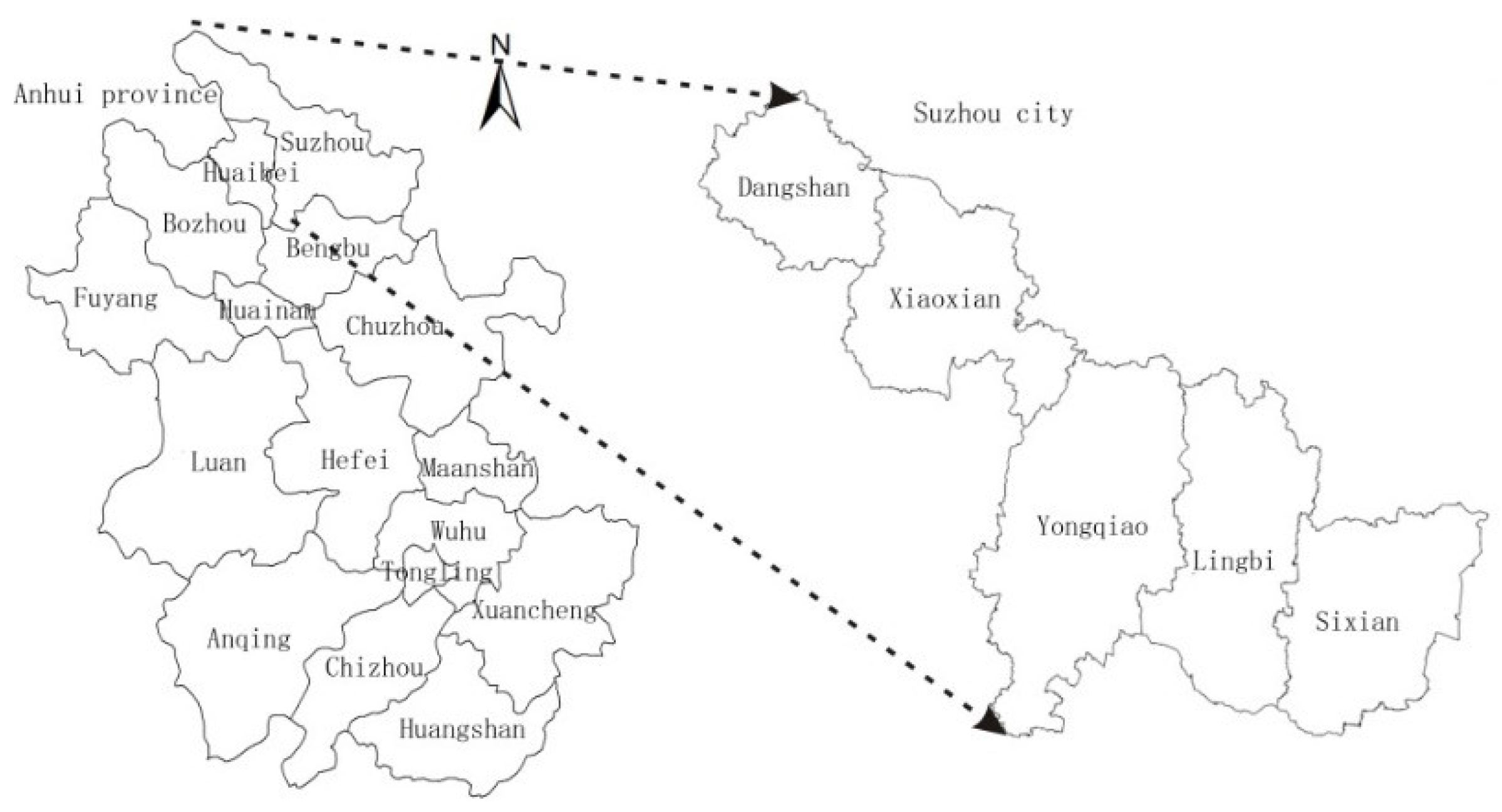
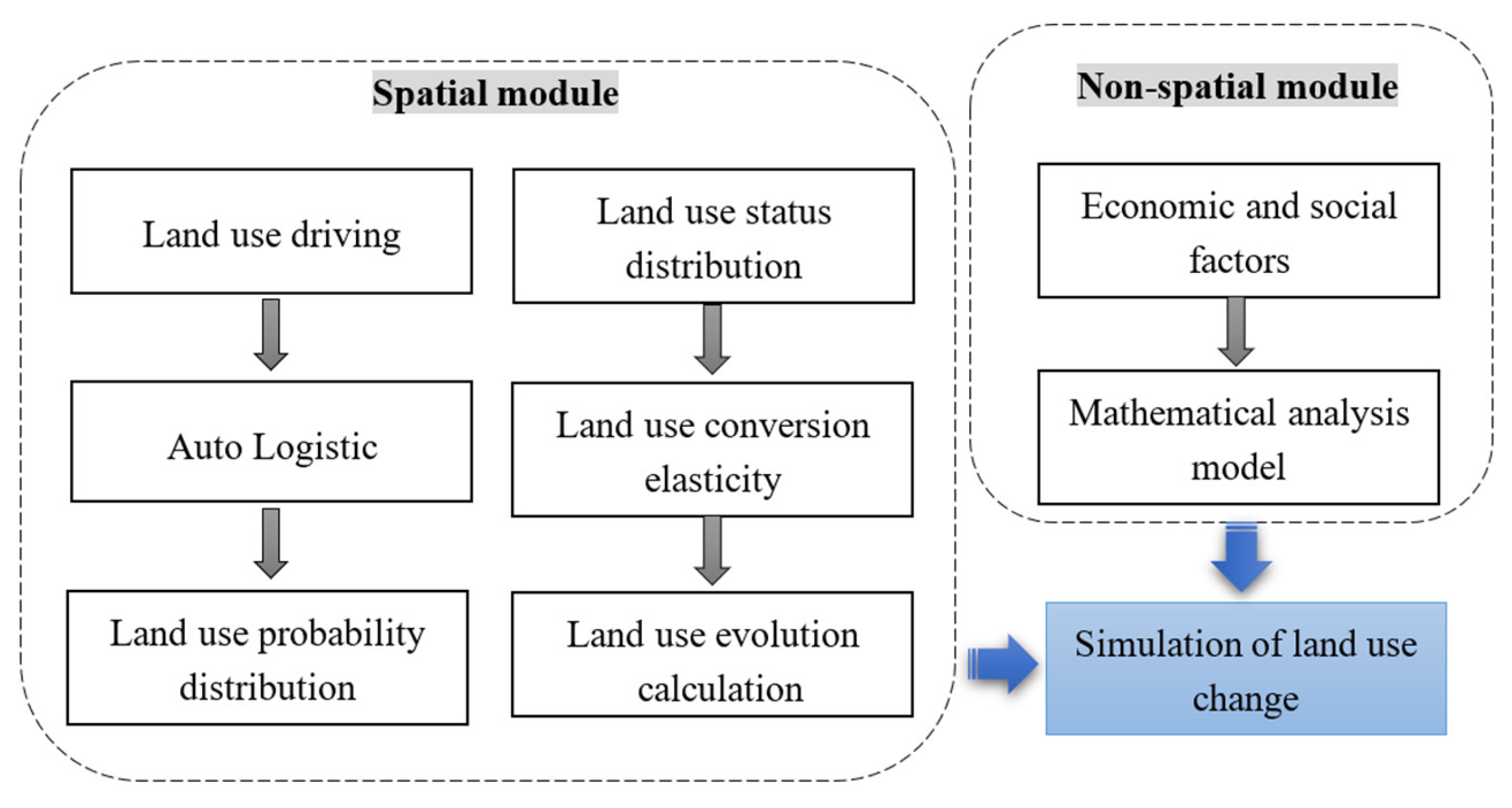
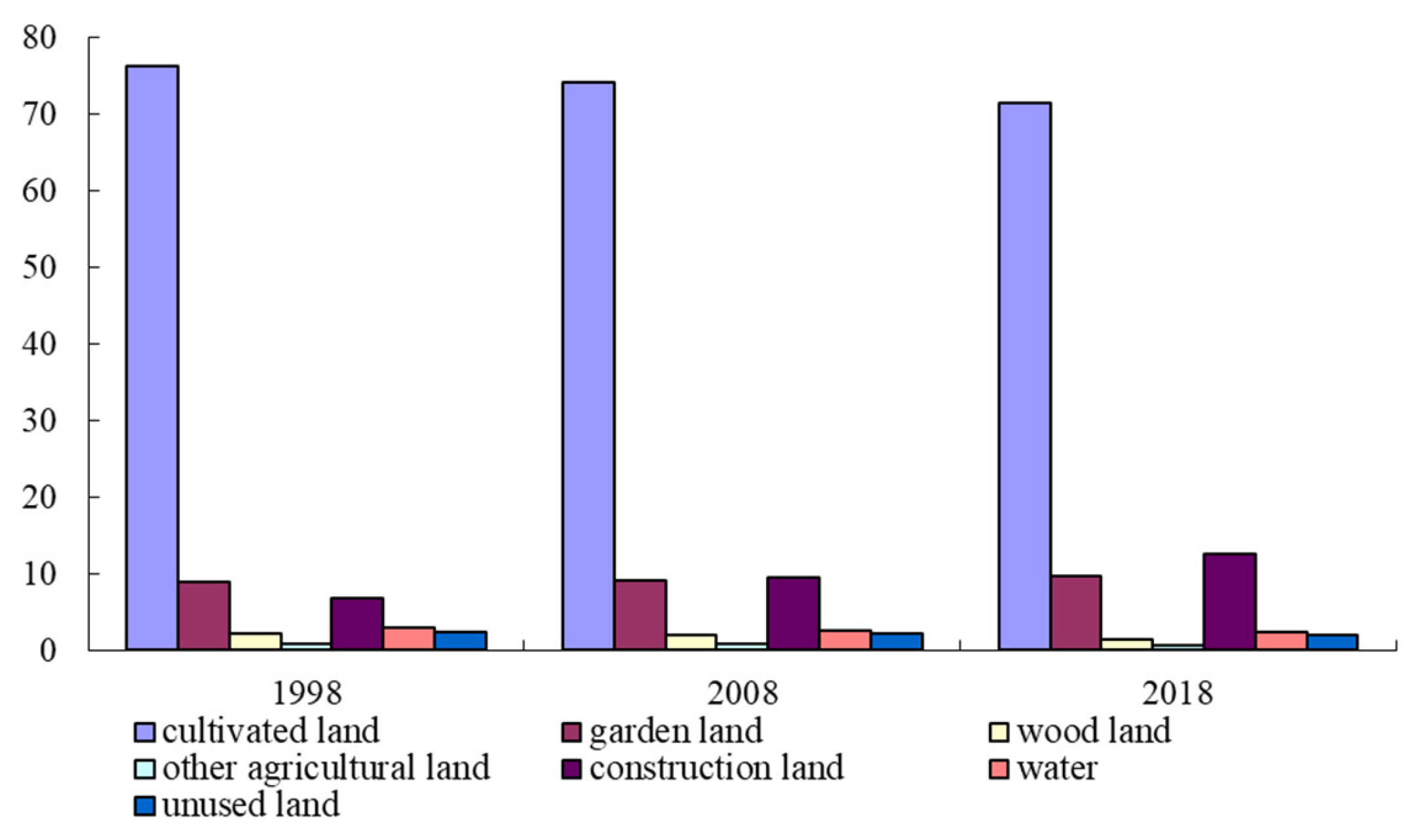
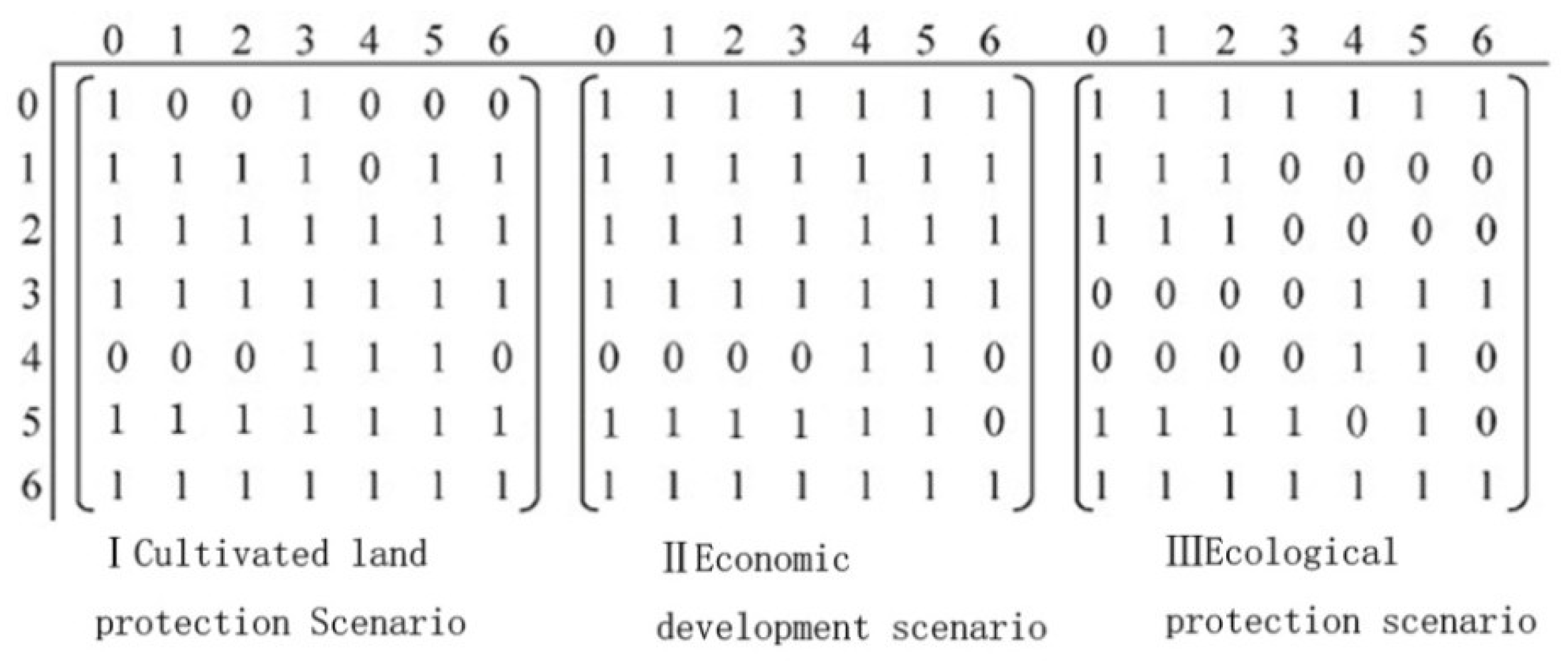
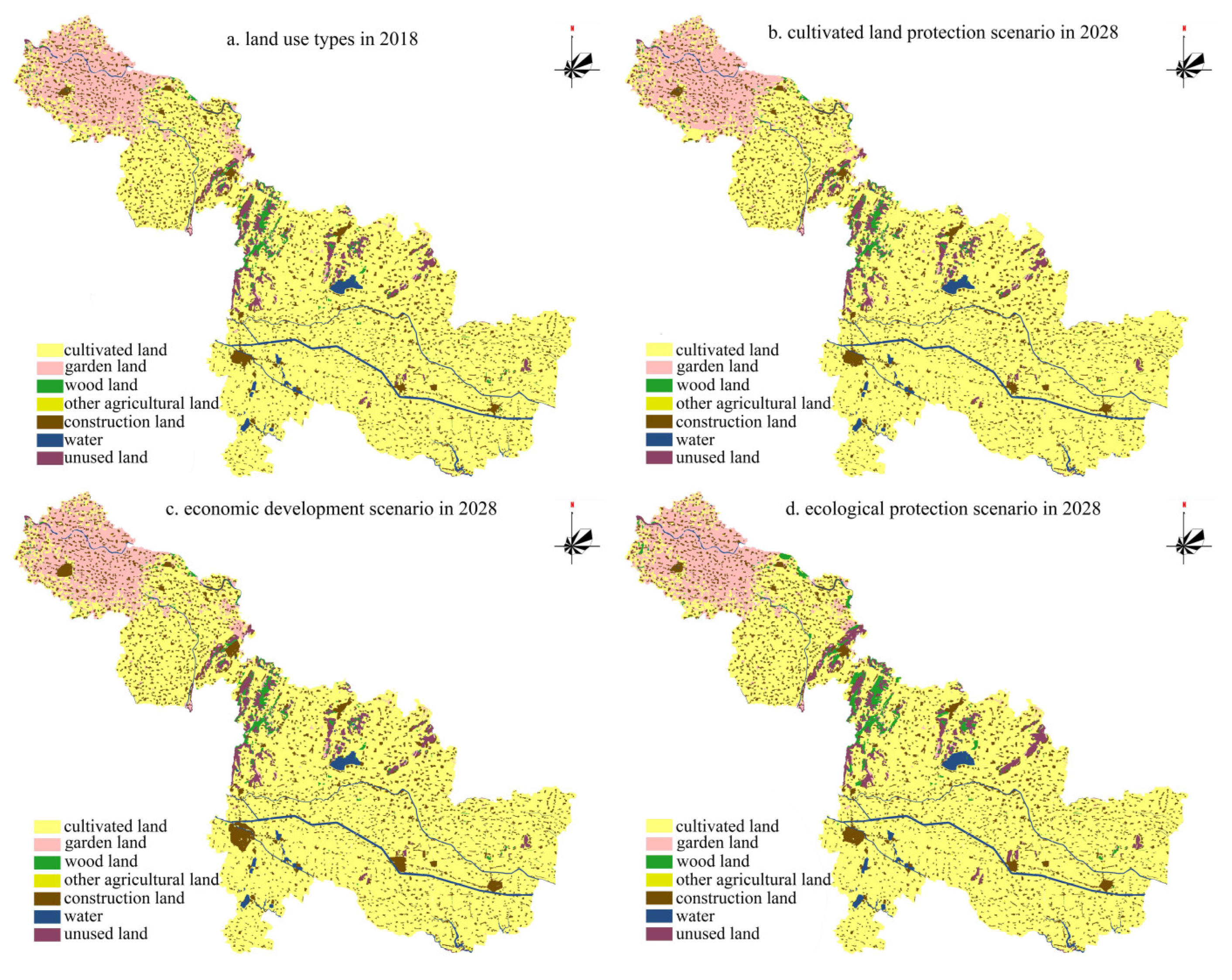

| 1998 | 2008 | ||||||
|---|---|---|---|---|---|---|---|
| Cultivated Land | Garden Land | Wood Land | Other Agricultural Land | Construction Land | Water | Unused Land | |
| Cultivated land | 93.14 | 1.23 | 0.02 | 1.02 | 4.56 | 0.03 | 0.00 |
| Garden land | 0.13 | 98.27 | 0.59 | 0.12 | 1.45 | 0.12 | 0.01 |
| Wood land | 0.43 | 0.03 | 98.14 | 0.23 | 0.35 | 0.13 | 0.00 |
| Other agricultural land | 0.45 | 0.87 | 0.13 | 95.75 | 2.56 | 0.23 | 0.01 |
| Construction land | 0.43 | 0.23 | 0.12 | 0.13 | 99.07 | 0.02 | 0.00 |
| Water | 0.51 | 0.36 | 0.23 | 0.55 | 0.49 | 97.84 | 0.02 |
| Unused land | 0.12 | 0.16 | 0.11 | 0.11 | 0.18 | 0.11 | 99.21 |
| 2008 | 2018 | ||||||
|---|---|---|---|---|---|---|---|
| Cultivated Land | Garden Land | Wood Land | Other Agricultural Land | Construction Land | Water | Unused Land | |
| Cultivated land | 91.55 | 1.54 | 0.09 | 1.12 | 5.65 | 0.05 | 0.00 |
| Garden land | 0.26 | 97.48 | 0.87 | 0.23 | 1.56 | 0.23 | 0.03 |
| Wood land | 0.56 | 0.13 | 97.56 | 0.43 | 0.55 | 0.11 | 0.00 |
| Other agricultural land | 0.56 | 0.79 | 0.32 | 95.08 | 2.89 | 0.35 | 0.01 |
| Construction land | 0.35 | 0.22 | 0.11 | 0.16 | 99.15 | 0.01 | 0.00 |
| Water | 0.42 | 0.36 | 0.25 | 0.42 | 0.45 | 98.09 | 0.01 |
| Unused land | 0.08 | 0.14 | 0.12 | 0.07 | 0.12 | 0.07 | 99.4 |
| Driving Factor | Cultivated Land | Garden Land | Wood Land | Other Agricultural Land | Construction Land | Water | Unused Land | |||||||
|---|---|---|---|---|---|---|---|---|---|---|---|---|---|---|
| Beta | Exp (β) | Beta | Exp (β) | Beta | Exp (β) | Beta | Exp (β) | Beta | Exp (β) | Beta | Exp (β) | Beta | Exp (β) | |
| Constant quantity | 0.453 | 1.563 | 0.165 | 1.003 | −0.187 | 0.894 | 0.078 | 0.956 | 0.198 | 0.967 | 0.289 | 0.987 | −0.023 | 0.903 |
| Distance from cities | 0.019 | 0.865 | −1.098 | 0.799 | −0.035 | 0.797 | 0.021 | 0.876 | 0.082 | 1.076 | 0.002 | 0.708 | −0.089 | 0.773 |
| Distance from rural | 0.042 | 1.087 | 0.024 | 0.902 | - | - | 0.045 | 0.892 | 0.024 | 0.878 | 0.023 | 0.854 | 0.045 | 0.928 |
| Distance from railways | - | - | - | - | - | - | - | - | 0.012 | 0.862 | - | - | - | - |
| Distance from highways | - | - | - | - | - | - | 0.004 | 0.862 | 0.045 | 0.893 | - | - | - | - |
| Distance from rivers | - | - | 0.021 | 0.898 | 0.063 | 1.002 | 0.089 | 0.895 | 0.067 | 0.954 | 0.073 | 1.045 | 0.043 | 0.913 |
| Elevation | −0.028 | 0.776 | 0.026 | 0.921 | 0.012 | 0.834 | 0.056 | 1.034 | 0.057 | 0.923 | 0.047 | 0.892 | 0.036 | 0.897 |
| Slope | −0.078 | 0.788 | 0.058 | 1.024 | 0.067 | 0.949 | 0.026 | 0.784 | 0.035 | 0.883 | 0.054 | 0.895 | 0.034 | 0.894 |
| Slope direction | −0.062 | 0.767 | 0.067 | 1.035 | 0.076 | 1.028 | 0.064 | 1.045 | 0.038 | 0.886 | 0.068 | 1.003 | 0.056 | 1.005 |
| Population density | 0.042 | 1.043 | −0.754 | 0.796 | 0.032 | 0.894 | 0.082 | 1.056 | 0.074 | 1.056 | 0.089 | 1.045 | 0.002 | 0.793 |
| Urbanization rate | 0.028 | 1.008 | 0.076 | 1.047 | 0.034 | 0.903 | 0.076 | 1.034 | 0.087 | 1.082 | 0.087 | 1.041 | −0.034 | 0.703 |
| Auto value | 0.001 | 1.004 | 0.001 | 1.002 | 0.002 | 1.005 | 0.001 | 1.002 | 0.002 | 1.006 | 0.004 | 0.713 | 0.002 | 1.001 |
| ROC | 0.826 | 0.851 | 0.894 | 0.882 | 0.843 | 0.903 | 0.912 | |||||||
| Land Use Type | Ⅰ Cultivated Land Protection Scenario | Ⅱ Economic Development Scenario | Ⅲ Ecological Protection Scenario |
|---|---|---|---|
| Cultivated land | 0.9 | 0.7 | 0.9 |
| Garden land | 0.8 | 0.8 | 0.8 |
| Wood land | 0.7 | 0.9 | 0.8 |
| Other agricultural land | 0.8 | 0.8 | 0.7 |
| Construction land | 0.9 | 0.9 | 0.9 |
| Water | 0.8 | 0.8 | 0.9 |
| Unused land | 0.9 | 0.9 | 0.9 |
| There Scenarios | Cultivated Land | Garden Land | Wood Land | Other Agricultural Land | Construction Land | Water | Unused Land |
|---|---|---|---|---|---|---|---|
| (Ⅰ) cultivated land protection scenario | 709,615.91 | 95,922.76 | 13,411.77 | 24,510.55 | 104,321.36 | 23,207.47 | 27,370.28 |
| (Ⅱ) economic development scenario | 702,089.75 | 95,758.12 | 12,776.65 | 21,694.85 | 119,964.78 | 21,988.85 | 24,087.07 |
| (Ⅲ) ecological protection scenario | 709,608.49 | 96,013.18 | 13,557.81 | 22,354.75 | 104,539.08 | 24,228.23 | 28,058.55 |
Publisher’s Note: MDPI stays neutral with regard to jurisdictional claims in published maps and institutional affiliations. |
© 2021 by the authors. Licensee MDPI, Basel, Switzerland. This article is an open access article distributed under the terms and conditions of the Creative Commons Attribution (CC BY) license (http://creativecommons.org/licenses/by/4.0/).
Share and Cite
Zhang, R.; Lu, J. Simulation of Land Use Pattern Evolution from a Multi-Scenario Perspective: A Case Study of Suzhou City in Anhui Province, China. Int. J. Environ. Res. Public Health 2021, 18, 921. https://doi.org/10.3390/ijerph18030921
Zhang R, Lu J. Simulation of Land Use Pattern Evolution from a Multi-Scenario Perspective: A Case Study of Suzhou City in Anhui Province, China. International Journal of Environmental Research and Public Health. 2021; 18(3):921. https://doi.org/10.3390/ijerph18030921
Chicago/Turabian StyleZhang, Rongtian, and Jianfei Lu. 2021. "Simulation of Land Use Pattern Evolution from a Multi-Scenario Perspective: A Case Study of Suzhou City in Anhui Province, China" International Journal of Environmental Research and Public Health 18, no. 3: 921. https://doi.org/10.3390/ijerph18030921
APA StyleZhang, R., & Lu, J. (2021). Simulation of Land Use Pattern Evolution from a Multi-Scenario Perspective: A Case Study of Suzhou City in Anhui Province, China. International Journal of Environmental Research and Public Health, 18(3), 921. https://doi.org/10.3390/ijerph18030921




